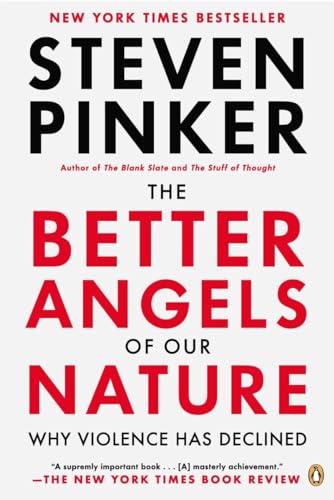
Synopsis
“If I could give each of you a graduation present, it would be this—the most inspiring book I've ever read." —Bill Gates
A provocative history of violence—from the New York Times bestselling author of The Stuff of Thought, The Blank Slate, and Enlightenment Now.
Believe it or not, today we may be living in the most peaceful moment in our species' existence. In his gripping and controversial new work, New York Times bestselling author Steven Pinker shows that despite the ceaseless news about war, crime, and terrorism, violence has actually been in decline over long stretches of history. Exploding myths about humankind's inherent violence and the curse of modernity, this ambitious book continues Pinker's exploration of the essence of human nature, mixing psychology and history to provide a remarkable picture of an increasingly enlightened world.
"synopsis" may belong to another edition of this title.
About the Author
Steven Pinker is the Harvard College Professor of Psychology at Harvard University. A two-time Pulitzer Prize finalist and the winner of many awards for his research, teaching, and books, he has been named one of Time's 100 Most Influential People in the World Today and Foreign Policy's 100 Global Thinkers.
"About this title" may belong to another edition of this title.
Other Popular Editions of the Same Title
Search results for The Better Angels of Our Nature: Why Violence Has Declined
The Better Angels of Our Natur
Seller: World of Books (was SecondSale), Montgomery, IL, U.S.A.
Condition: Good. Item in good condition. Textbooks may not include supplemental items i.e. CDs, access codes etc. Seller Inventory # 00090517812
The Better Angels of Our Natur
Seller: World of Books (was SecondSale), Montgomery, IL, U.S.A.
Condition: Good. Item in good condition and has highlighting/writing on text. Used texts may not contain supplemental items such as CDs, info-trac etc. Seller Inventory # 00094469278
The Better Angels of Our Natur
Seller: World of Books (was SecondSale), Montgomery, IL, U.S.A.
Condition: Very Good. Item in very good condition! Textbooks may not include supplemental items i.e. CDs, access codes etc. Seller Inventory # 00094265274
The Better Angels of Our Nature: Why Violence Has Declined
Seller: Dream Books Co., Denver, CO, U.S.A.
Condition: acceptable. This copy has clearly been enjoyed‚"expect noticeable shelf wear and some minor creases to the cover. Binding is strong, and all pages are legible. May contain previous library markings or stamps. Seller Inventory # 4EKGY3007TKJ_ns
The Better Angels of Our Nature: Why Violence Has Declined
Seller: Zoom Books East, Glendale Heights, IL, U.S.A.
Condition: acceptable. Book is in acceptable condition and shows signs of wear. Book may also include underlining highlighting. The book can also include "From the library of" labels. May not contain miscellaneous items toys, dvds, etc. . We offer 100% money back guarantee and 24 7 customer service. Seller Inventory # ZEV.0143122010.A
The Better Angels of Our Nature: Why Violence Has Declined
Seller: Zoom Books East, Glendale Heights, IL, U.S.A.
Condition: good. Book is in good condition and may include underlining highlighting and minimal wear. The book can also include "From the library of" labels. May not contain miscellaneous items toys, dvds, etc. . We offer 100% money back guarantee and 24 7 customer service. Seller Inventory # ZEV.0143122010.G
The Better Angels of Our Nature: Why Violence Has Declined
Seller: Dream Books Co., Denver, CO, U.S.A.
Condition: good. Gently used with minimal wear on the corners and cover. A few pages may contain light highlighting or writing, but the text remains fully legible. Dust jacket may be missing, and supplemental materials like CDs or codes may not be included. May be ex-library with library markings. Ships promptly! Seller Inventory # 4EKGY3008T6Q_ns
The Better Angels of Our Nature: Why Violence Has Declined
Seller: Zoom Books Company, Lynden, WA, U.S.A.
Condition: very_good. Book is in very good condition and may include minimal underlining highlighting. The book can also include "From the library of" labels. May not contain miscellaneous items toys, dvds, etc. . We offer 100% money back guarantee and 24 7 customer service. Seller Inventory # ZBV.0143122010.VG
The Better Angels of Our Nature: Why Violence Has Declined
Seller: Zoom Books East, Glendale Heights, IL, U.S.A.
Condition: very_good. Book is in very good condition and may include minimal underlining highlighting. The book can also include "From the library of" labels. May not contain miscellaneous items toys, dvds, etc. . We offer 100% money back guarantee and 24 7 customer service. Seller Inventory # ZEV.0143122010.VG
The Better Angels of Our Nature: Why Violence Has Declined
Seller: Greenworld Books, Arlington, TX, U.S.A.
Condition: good. Fast Free Shipping ‚" Good condition book with a firm cover and clean, readable pages. Shows normal use, including some light wear or limited notes highlighting, yet remains a dependable copy overall. Supplemental items like CDs or access codes may not be included. Seller Inventory # GWV.0143122010.G

